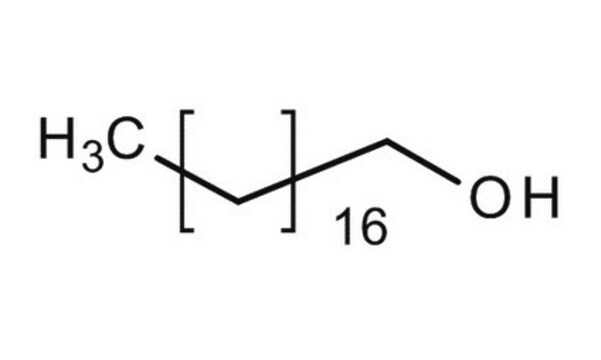Kluczowe dokumenty
369314
Oleyl alcohol
technical grade, 85%
Synonim(y):
Z-9-Dodecen-1-ol, cis-9-Octadecen-1-ol
About This Item
Polecane produkty
klasa czystości
technical grade
Poziom jakości
Próba
85%
Formularz
liquid
współczynnik refrakcji
n20/D 1.46 (lit.)
bp
207 °C/13 mmHg (lit.)
mp
0-5.0 °C (lit.)
gęstość
0.849 g/mL at 25 °C (lit.)
grupa funkcyjna
hydroxyl
ciąg SMILES
CCCCCCCC\C=C/CCCCCCCCO
InChI
1S/C18H36O/c1-2-3-4-5-6-7-8-9-10-11-12-13-14-15-16-17-18-19/h9-10,19H,2-8,11-18H2,1H3/b10-9-
Klucz InChI
ALSTYHKOOCGGFT-KTKRTIGZSA-N
Szukasz podobnych produktów? Odwiedź Przewodnik dotyczący porównywania produktów
Powiązane kategorie
Opis ogólny
Zastosowanie
Kod klasy składowania
10 - Combustible liquids
Klasa zagrożenia wodnego (WGK)
awg
Temperatura zapłonu (°F)
338.0 °F - closed cup
Temperatura zapłonu (°C)
170 °C - closed cup
Środki ochrony indywidualnej
Eyeshields, Gloves, type ABEK (EN14387) respirator filter
Wybierz jedną z najnowszych wersji:
Masz już ten produkt?
Dokumenty związane z niedawno zakupionymi produktami zostały zamieszczone w Bibliotece dokumentów.
Klienci oglądali również te produkty
Nasz zespół naukowców ma doświadczenie we wszystkich obszarach badań, w tym w naukach przyrodniczych, materiałoznawstwie, syntezie chemicznej, chromatografii, analityce i wielu innych dziedzinach.
Skontaktuj się z zespołem ds. pomocy technicznej











